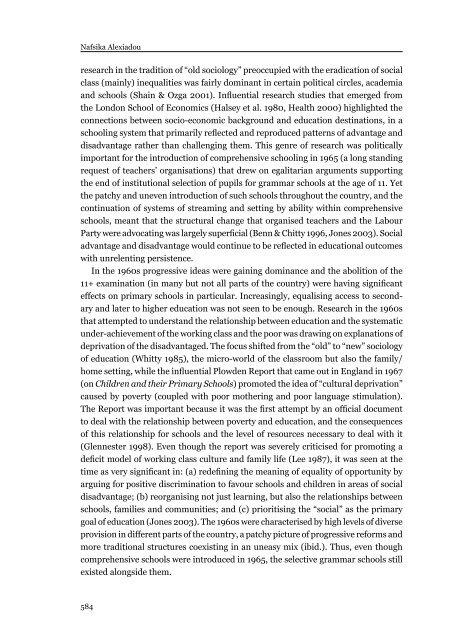Social inclusion and leadership in education: An evolution of roles ...
Social inclusion and leadership in education: An evolution of roles ...
Social inclusion and leadership in education: An evolution of roles ...
- No tags were found...
You also want an ePaper? Increase the reach of your titles
YUMPU automatically turns print PDFs into web optimized ePapers that Google loves.
Nafsika Alexiadouresearch <strong>in</strong> the tradition <strong>of</strong> “old sociology” preoccupied with the eradication <strong>of</strong> socialclass (ma<strong>in</strong>ly) <strong>in</strong>equalities was fairly dom<strong>in</strong>ant <strong>in</strong> certa<strong>in</strong> political circles, academia<strong>and</strong> schools (Sha<strong>in</strong> & Ozga 2001). Influential research studies that emerged fromthe London School <strong>of</strong> Economics (Halsey et al. 1980, Health 2000) highlighted theconnections between socio-economic background <strong>and</strong> <strong>education</strong> dest<strong>in</strong>ations, <strong>in</strong> aschool<strong>in</strong>g system that primarily reflected <strong>and</strong> reproduced patterns <strong>of</strong> advantage <strong>and</strong>disadvantage rather than challeng<strong>in</strong>g them. This genre <strong>of</strong> research was politicallyimportant for the <strong>in</strong>troduction <strong>of</strong> comprehensive school<strong>in</strong>g <strong>in</strong> 1965 (a long st<strong>and</strong><strong>in</strong>grequest <strong>of</strong> teachers’ organisations) that drew on egalitarian arguments support<strong>in</strong>gthe end <strong>of</strong> <strong>in</strong>stitutional selection <strong>of</strong> pupils for grammar schools at the age <strong>of</strong> 11. Yetthe patchy <strong>and</strong> uneven <strong>in</strong>troduction <strong>of</strong> such schools throughout the country, <strong>and</strong> thecont<strong>in</strong>uation <strong>of</strong> systems <strong>of</strong> stream<strong>in</strong>g <strong>and</strong> sett<strong>in</strong>g by ability with<strong>in</strong> comprehensiveschools, meant that the structural change that organised teachers <strong>and</strong> the LabourParty were advocat<strong>in</strong>g was largely superficial (Benn & Chitty 1996, Jones 2003). <strong>Social</strong>advantage <strong>and</strong> disadvantage would cont<strong>in</strong>ue to be reflected <strong>in</strong> <strong>education</strong>al outcomeswith unrelent<strong>in</strong>g persistence.In the 1960s progressive ideas were ga<strong>in</strong><strong>in</strong>g dom<strong>in</strong>ance <strong>and</strong> the abolition <strong>of</strong> the11+ exam<strong>in</strong>ation (<strong>in</strong> many but not all parts <strong>of</strong> the country) were hav<strong>in</strong>g significanteffects on primary schools <strong>in</strong> particular. Increas<strong>in</strong>gly, equalis<strong>in</strong>g access to secondary<strong>and</strong> later to higher <strong>education</strong> was not seen to be enough. Research <strong>in</strong> the 1960sthat attempted to underst<strong>and</strong> the relationship between <strong>education</strong> <strong>and</strong> the systematicunder-achievement <strong>of</strong> the work<strong>in</strong>g class <strong>and</strong> the poor was draw<strong>in</strong>g on explanations <strong>of</strong>deprivation <strong>of</strong> the disadvantaged. The focus shifted from the “old” to “new” sociology<strong>of</strong> <strong>education</strong> (Whitty 1985), the micro-world <strong>of</strong> the classroom but also the family/home sett<strong>in</strong>g, while the <strong>in</strong>fluential Plowden Report that came out <strong>in</strong> Engl<strong>and</strong> <strong>in</strong> 1967(on Children <strong>and</strong> their Primary Schools) promoted the idea <strong>of</strong> “cultural deprivation”caused by poverty (coupled with poor mother<strong>in</strong>g <strong>and</strong> poor language stimulation).The Report was important because it was the first attempt by an <strong>of</strong>ficial documentto deal with the relationship between poverty <strong>and</strong> <strong>education</strong>, <strong>and</strong> the consequences<strong>of</strong> this relationship for schools <strong>and</strong> the level <strong>of</strong> resources necessary to deal with it(Glennester 1998). Even though the report was severely criticised for promot<strong>in</strong>g adeficit model <strong>of</strong> work<strong>in</strong>g class culture <strong>and</strong> family life (Lee 1987), it was seen at thetime as very significant <strong>in</strong>: (a) redef<strong>in</strong><strong>in</strong>g the mean<strong>in</strong>g <strong>of</strong> equality <strong>of</strong> opportunity byargu<strong>in</strong>g for positive discrim<strong>in</strong>ation to favour schools <strong>and</strong> children <strong>in</strong> areas <strong>of</strong> socialdisadvantage; (b) reorganis<strong>in</strong>g not just learn<strong>in</strong>g, but also the relationships betweenschools, families <strong>and</strong> communities; <strong>and</strong> (c) prioritis<strong>in</strong>g the “social” as the primarygoal <strong>of</strong> <strong>education</strong> (Jones 2003). The 1960s were characterised by high levels <strong>of</strong> diverseprovision <strong>in</strong> different parts <strong>of</strong> the country, a patchy picture <strong>of</strong> progressive reforms <strong>and</strong>more traditional structures coexist<strong>in</strong>g <strong>in</strong> an uneasy mix (ibid.). Thus, even thoughcomprehensive schools were <strong>in</strong>troduced <strong>in</strong> 1965, the selective grammar schools stillexisted alongside them.584

















